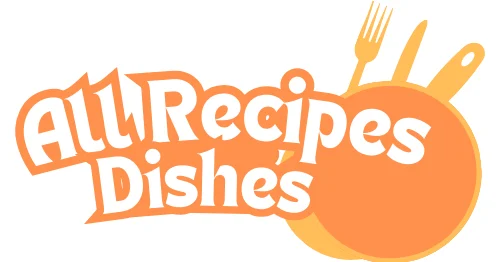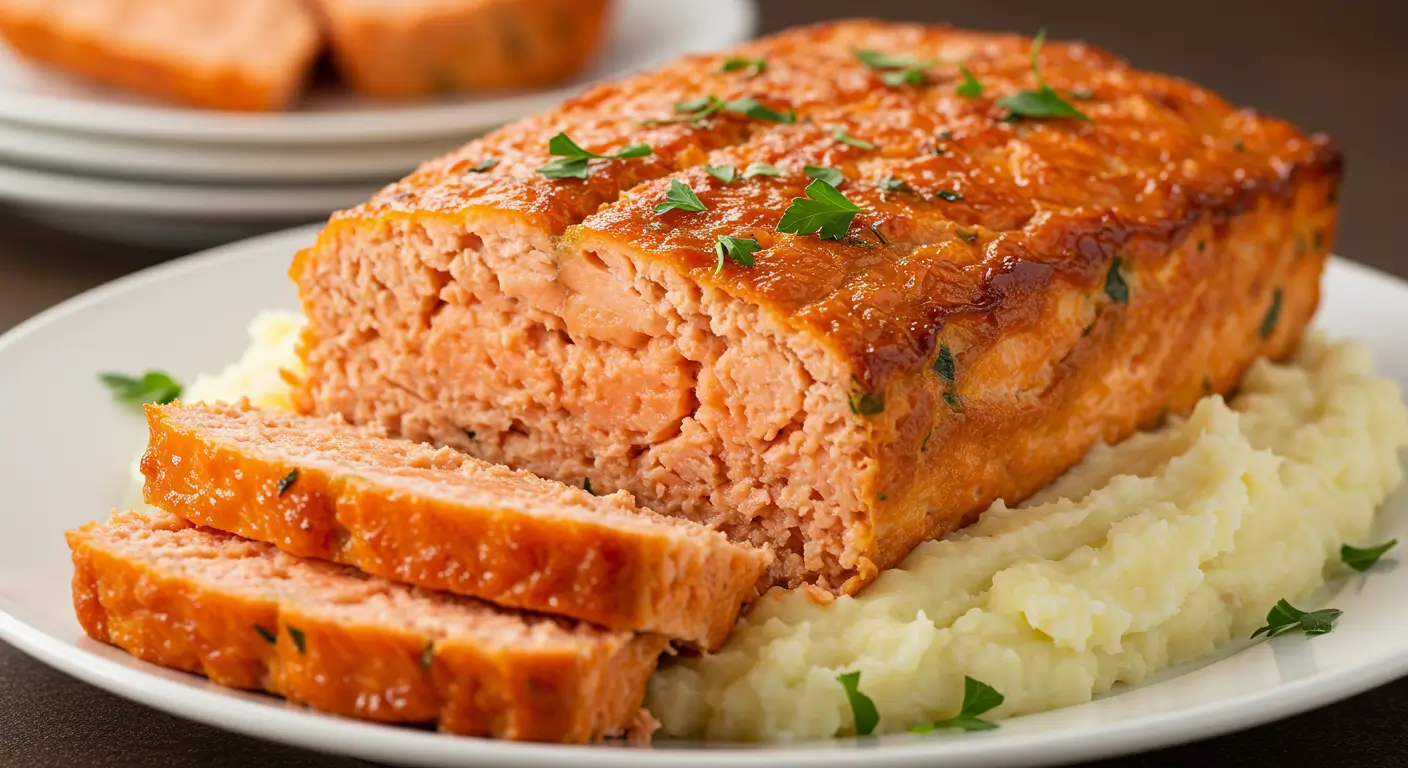Salmon Loaf: A Tasty and Delicious Seafood Dish
Table of Contents
Looking for a tasty and easy seafood dish? Try a tasty salmon-loaf. It’s great for any meal because of its versatility. A seafood dish like salmon loaf is a tasty change from usual meals. It’s full of nutrients, making it a healthy choice. You can have salmon loaf as a main dish or in sandwiches and wraps. Its rich flavor and adaptability make it suitable for any meal.
Key Takeaways
- Salmon loaf is a savory and flexible seafood dish.
- It’s a great alternative to traditional meals.
- Packed with nutrients, making it a healthy option.
- Can be enjoyed in various ways, including as a main course or in sandwiches.
- Perfect for any meal or occasion.
What Is Salmon Loaf and Its Culinary Heritage
Salmon loaf comes from traditional American cooking. It’s both healthy and tasty. You might wonder what makes it so unique.
Definition and Basic Concept
Salmon-loaf mixes salmon with breadcrumbs, eggs, and spices. Then, it’s baked into a loaf shape. It’s a great way to enjoy salmon in a new way. The idea is to blend salmon’s flavors with other ingredients for a complete meal.
Origins in American Home Cooking
Salmon loaf started in American home cooking. Cooks used canned salmon to make a filling meal. This was common when fresh salmon was hard to find. The dish became popular because it was easy and cheap to make.
Evolution Through the Decades
Over time, salmon loaf has changed a lot. Today, recipes use fresh salmon and add herbs, spices, and veggies for more flavor. Some common changes include:
- Adding Mediterranean herbs like dill and parsley
- Incorporating spicy elements for a bold twist
- Using different types of salmon, such as Atlantic or Sockeye, for varying flavors
Try these variations to make your own salmon-loaf recipe.
Essential Ingredients for a Delicious Salmon Loaf
Selecting quality ingredients is essential for a flavorful salmon loaf. These ingredients should work well together. This makes the dish special and enjoyable to eat.
Core Components
The heart of a great salmon loaf is its core ingredients. These include:
- Salmon (fresh or canned)
- Breadcrumbs or panko
- Binding agents like eggs
- Moisture-rich ingredients such as mayonnaise or Greek yogurt
- Flavor enhancers like onion, garlic, and herbs
Together, these ingredients give the salmon-loaf its shape, moisture, and taste.
| Ingredient | Function |
|---|---|
| Salmon | Main protein source |
| Breadcrumbs/Panko | Texture and binding |
| Eggs | Binding agent |
| Mayonnaise/Greek Yogurt | Moisture and creaminess |
| Onion, Garlic, Herbs | Flavor enhancement |
Optional Add-ins for Enhanced Flavor
For more flavor, add optional ingredients. Try diced bell peppers, chopped herbs, or grated cheese. You can also use different seasonings like paprika or cayenne pepper.
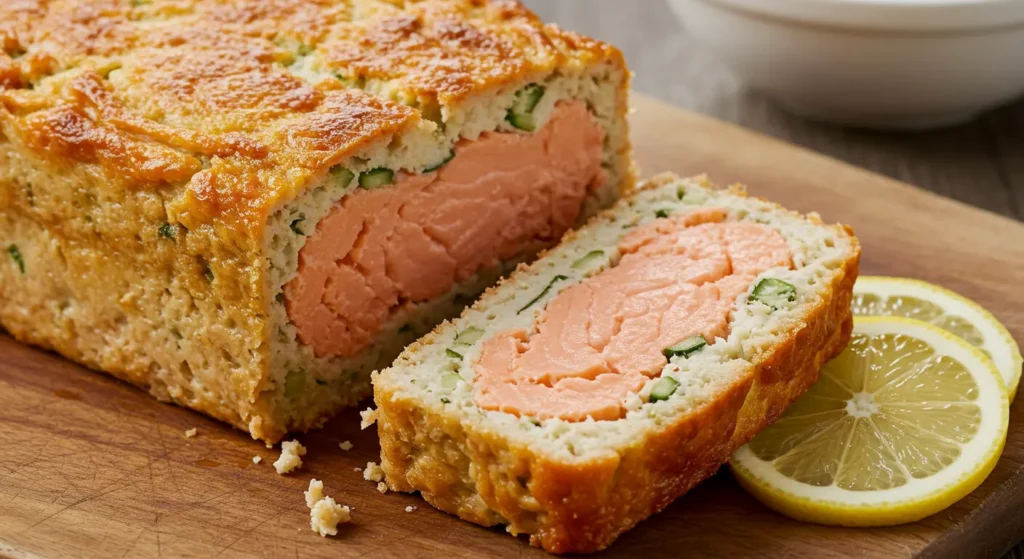
Fresh vs. Canned Salmon Considerations
Choosing between fresh or canned salmon is important. Fresh salmon tastes better and has a firmer texture. But, it takes more work to prepare. Canned salmon is quicker and easier, but it might be wetter and less flavorful. Your choice depends on your taste, time, and the recipe you’re using.
Step-by-Step Guide to Making Salmon Loaf
To make a tasty salmon loaf, follow a few easy steps. These steps ensure your loaf is moist and full of flavor. You’ll need to prepare the ingredients, mix them, shape the loaf, and cook it right.
Preparation Techniques
First, heat your oven to 375°F (190°C). While it warms up, get your salmon-loaf mix ready. If using canned salmon, drain it and flake it into a big bowl.
Add chopped onions, beaten eggs, and breadcrumbs to the bowl with the salmon. Mix everything gently until just combined. Avoid overmixing to prevent a dense texture in the loaf.
Cooking Methods and Times
Shape the mix into a loaf and put it on a baking sheet covered with parchment paper. Bake the salmon loaf in the preheated oven for 25-35 minutes. It should be cooked through and lightly browned on top.
To check if it’s done, insert a knife or fork into the center. Insert a toothpick into the center; if it comes out clean, the loaf is done.
Troubleshooting Common Issues
If your salmon loaf is dry, it might be because it was overcooked or overmixed. To avoid this, watch the loaf while it’s baking. Mix the ingredients just until they’re combined.
If the loaf isn’t browning as you’d like, try broiling it for 2-3 minutes after baking. Just watch it closely to prevent burning.
Nutritional Benefits of Salmon Loaf
Salmon loaf is packed with essential nutrients, making it a great choice for dinner. It offers many health benefits, making it a nutritious option.
Protein and Omega-3 Content
Salmon-loaf serves as an excellent protein source, essential for muscle maintenance and growth. It also has lots of omega-3 fatty acids. These are good for your heart and brain. Adding salmon-loaf to your meals can help you get enough protein and omega-3s.
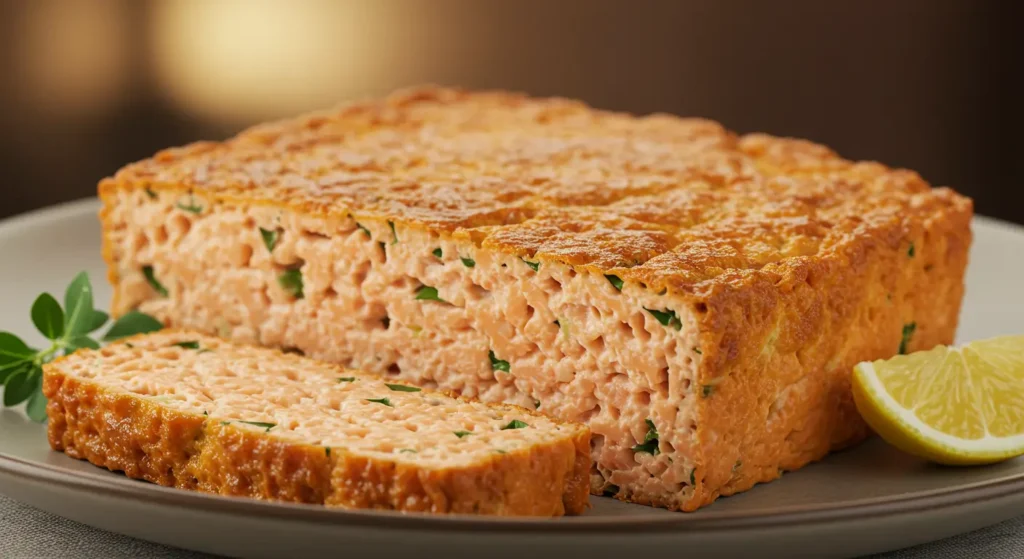
Caloric and Macronutrient Breakdown
A serving of salmon loaf has a good balance of calories, proteins, and fats. It has less saturated fats and carbs, making it a healthy choice. The calorie content of salmon loaf varies depending on the specific recipe and ingredients used.
Health Advantages Compared to Other Protein Dishes
Salmon loaf has more omega-3s and less saturated fats than many other protein dishes. This makes it better for your heart. It also has fewer calories, helping with weight control.
Choosing salmon-loaf means you’re enjoying a tasty meal that’s also good for you. It supports your overall health and well-being.
Creative Salmon Loaf Variations
Turn the classic salmon loaf into a fun culinary journey with these new and tasty variations. Looking to spice up your meals or meet specific dietary needs? These creative salmon-loaf twists will surely wow you.
Mediterranean-Style Salmon-Loaf
Add the bright tastes of the Mediterranean to your salmon-loaf. Incorporate feta cheese, Kalamata olives, and sun-dried tomatoes for a Mediterranean twist. This adds a salty, tangy flavor that pairs well with the salmon.
Spicy Southwest Salmon Loaf
For a spicy kick, try the Spicy Southwest Salmon Loaf. Add diced jalapeños, chipotle peppers, or spicy seasonings. Serve it with avocado or sour cream to balance the heat.
Herb and Lemon Salmon-Loaf
The Herb and Lemon Salmon Loaf is perfect for spring or summer. Enhance the flavor by blending in fresh herbs such as parsley, dill, or basil. Add a squeeze of lemon juice and some grated lemon zest for a bright, citrusy taste.
Gluten-Free and Dairy-Free Options
To make your salmon-loaf gluten-free, use almond meal or gluten-free breadcrumbs instead of traditional breadcrumbs. For a dairy-free version, replace eggs with flax eggs or use dairy-free milk. These changes let everyone enjoy a tasty salmon loaf, no matter their dietary needs.
Serving and Storing Your Salmon Loaf
Finishing your salmon-loaf means picking the right sides and storing leftovers. A complete meal includes the main dish, sides, and how to enjoy leftovers.
Classic Side Dish Pairings
Classic sides can make your salmon-loaf meal better. Try it with roasted veggies like asparagus or Brussels sprouts for a tasty and healthy choice. Mashed potatoes or a fresh green salad also pair well with the salmon’s rich flavor.
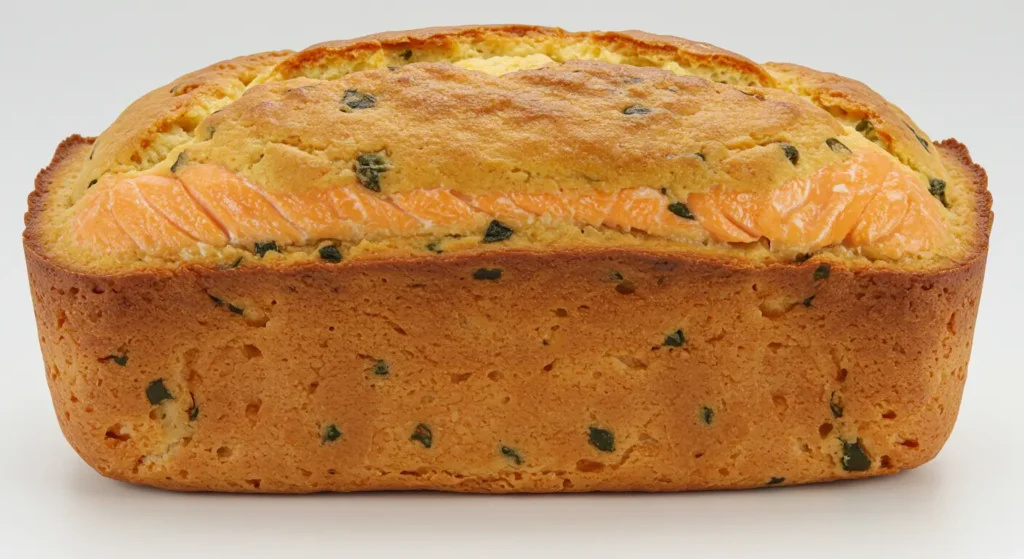
Sauce and Garnish Options
Adding a sauce or garnish can boost your salmon-loaf’s taste and look. A lemon-dill sauce or tangy tartar sauce adds a nice touch. Fresh herbs like parsley or dill can also brighten up your dish.
Storage, Freezing, and Reheating Tips
To store your salmon-loaf, cool it down first. Then, wrap it tightly in plastic wrap or foil and refrigerate. For longer storage, freeze it for up to 3 months. Reheat it in the oven at 350°F (175°C) until it’s warm.
Creative Ideas for Leftover Salmon Loaf
Leftover salmon-loaf can be turned into new dishes. Make salmon cakes by crumbling the loaf, mixing with breadcrumbs and egg, and pan-frying until crispy. You can also use it in salads or sandwiches for a quick meal.
Salmon-Loaf: A Deliciously Versatile Dish to Savor
Salmon loaf is a culinary delight that combines taste, nutrition, and versatility. It’s perfect for those who love to cook and eat well. By learning about its history, ingredients, and cooking methods, you can make it at home.
This dish is packed with protein and omega-3s, making it great for your health. You can add a Mediterranean twist or a spicy kick to it. This makes salmon-loaf a fantastic choice for any meal.
In conclusion, salmon loaf is a dish that will impress anyone. It’s full of flavor and good for you. So, get your ingredients ready, start cooking, and enjoy the delicious taste of salmon-loaf.
FAQ
What is salmon-loaf made of?
Salmon loaf is made from salmon, breadcrumbs, eggs, and seasonings. These can include onions, garlic, and herbs like parsley or dill.
Can I use canned salmon to make salmon loaf?
Yes, canned salmon is a great alternative to fresh salmon. Just drain the liquid and remove bones or skin before using.
How do I prevent salmon loaf from falling apart?
To keep salmon-loaf together, mix ingredients just until they combine. Avoid overmixing and use enough eggs and breadcrumbs as binders.
Can I freeze salmon-loaf?
Yes, you can freeze salmon-loaf. Cool it completely, then wrap it in plastic or foil. Store it in the freezer for up to 3 months. Store it in the freezer for up to 3 months.
What are some common side dishes that go well with salmon-loaf?
Classic sides for salmon loaf include mashed potatoes, steamed veggies, roasted asparagus, and a green salad.
How do I reheat leftover salmon loaf?
Reheat salmon loaf in the oven or microwave. For the oven, wrap it in foil and heat at 350°F (175°C) for 15-20 minutes. For the microwave, slice it and heat on a plate for 20-30 seconds.
Can I make salmon-loaf gluten-free?
Yes, make salmon-loaf gluten-free by using gluten-free breadcrumbs or crushed crackers. Be careful with your recipe’s ingredients.
